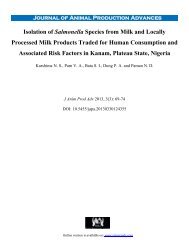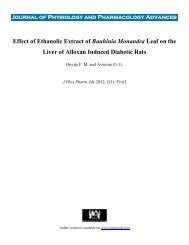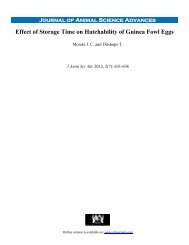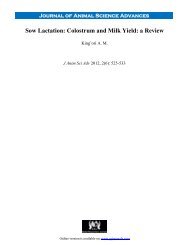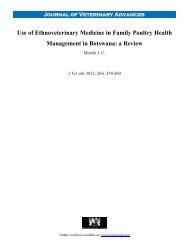PDF Download - Global Researchers Journals
PDF Download - Global Researchers Journals
PDF Download - Global Researchers Journals
Create successful ePaper yourself
Turn your PDF publications into a flip-book with our unique Google optimized e-Paper software.
Journal of Veterinary Advances<br />
Antitrypanosomal Effects of Brassica Oleracea (Cabbage)<br />
Fruits and Leaves<br />
Shaba P., Pandey N. N., Sharma O. P., Rao J. R. and Singh R. K.<br />
J Vet Adv 2012, 2(7): 304-401<br />
Online version is available on: www.grjournals.com
ISSN: 2251-7685<br />
SHABA ET AL.<br />
Antitrypanosomal Effects of Brassica Oleracea<br />
(Cabbage) Fruits and Leaves<br />
Original Article<br />
1 Shaba P., 1 Pandey N. N., 2 Sharma O. P., 3 Rao J. R. and 4 Singh R. K.<br />
1 Division of Medicine, Indian Veterinary Research Institute, Izatnagar, Uttar Pradesh (243 122), India<br />
2 Indian Veterinary Research Institute, Regional Station, Palampur, Himachal Pradesh, (176 061) India<br />
3 Division of Parasitology, Indian Veterinary Research Institute, Izatnagar (243 122), India<br />
4 Indian Veterinary Research Institute, Regional Station, Mukteswar, Uttranchal, (263 138) India<br />
Abstract<br />
In our continuation of search for antitrypanosomal agents from medicinal plants and other sources,<br />
Brassica oleracea (cabbage) fruits and leaves were screened for their antitrypanosomal and cytotoxicity effects<br />
.Methanolic plant extracts (MPES) of B. Oleracea fruits and leaves at different concentrations (250-1000<br />
µg/ml) were tested against Trypanosoma evansi on Vero cell line grown in Dulbecco’s Modified Eagle Medium<br />
(DMEM) with foetal calf serum (FCS) (20-40%) at appropriate conditions. In vivo infectivity test of incubated<br />
MPES of B. Oleracea fruits, leaves and medium with trypanosomes were done in mice. In vitro cytotoxicity of<br />
the test extracts at concentrations (1.56-100 µg/ml) were performed on Vero cells but without FCS. Both MPES<br />
of B. oleracea fruits and leaves demonstrated trypanocidal activity, which ranged from immobilization,<br />
reduction and to the killing of trypanosomes. At 500 µg/ml of MPES of B. oleracea fruits and leaves with<br />
trypanosomes undergoing incubation, there were marked reductions of trypanosomes (19.33±0.33)<br />
(15.33±0.33) in the corresponding ELISA plate wells. But at 1000 µg/ml of MPE of B. oleracea fruits, there<br />
was no complete killing of the trypanosomes (5.33±0.33) as to that of MPE of leaves where trypanosomes could<br />
not be detected at 7 h of incubation, which was statistical comparable to the standard drug, diminazine aceturate<br />
at concentration of 50 µg/ml at 4 h of incubation. Trypanosomes counts decreased in concentration and time –<br />
dependent manner with significant difference (P
ANTITRYPANOSOMAL EFFECTS OF BRASSICA OLERACEA …<br />
Introduction<br />
Trypanosoma evansi is one of the species of the<br />
genus Trypanosoma that causes trypanosomosis in<br />
animals (Soulsby, 1982; Seed,<br />
2001).Trypanosomosis being a zoonotic disease in<br />
nature has great impacts on both animals and<br />
humans especially where the disease thrives (WHO,<br />
2004).<br />
Trypanosomosis act as a hindrance to livestock<br />
production in endemic areas of Africa where the<br />
disease is rampart. (Freiburghaus et al., 1998;<br />
WHO, 2002)<br />
Chemoprophylaxis and chemotherapy are the<br />
two major means of tackling the menace of the<br />
disease. But these means are faced with lots of<br />
challenges such as high cost of the available<br />
trypanocides, limited classes of trypanocides and<br />
emerged resistant strains of trypanosomes .Also,<br />
reports of resistance to the available trypanocides<br />
are on the increase (WHO, 2004; Dou and Yapo,<br />
2001; Gutteridge, 1985).<br />
Natural products are valuable sources for new<br />
drug formulation. Important classes of antimalarial<br />
drugs such as quinoline and endoperoxide<br />
atermisinin deravatives were originally identified<br />
from traditional medicine (El-Sayed et al., 2001).<br />
Traditional uses of B. oleracea fruits and leaves<br />
include condiment and consumed as vegetables (de<br />
Pascual-Teresa et al., 2010).<br />
Biological activity such as anti-inflammatory,<br />
enzyme inhibition, and antioxidant, ant allergic and<br />
vascular and cytotoxic antitumor activity has been<br />
reported (Chu et al., 2000; Podsedek et al., 2006).<br />
Isolated compound such as tannins,<br />
antthocynins, hydroxycinnamic acids, flavonoids –<br />
flavones, flavan-3-ols, isoflavones have been<br />
reported (de Pascual-Teresa et al., 2010; Cushnie et<br />
al., 2005).<br />
Prospects of introducing new trypanocidal<br />
drugs into the market are also not encouraging.<br />
Therefore, there is an urgent need for development<br />
of newer anti-trypanosomal drug. On this note,<br />
Brassica oleracea (cabbage) fruits and leaves were<br />
screened for their trypanocidal activity.<br />
Chemicals<br />
Material and Methods<br />
305 J. Vet. Adv., 2012, 2(7):304-401<br />
Silica gel-G for thin layer chromatography<br />
(TLC), solvents (hexane, chloroform, methanol,<br />
acetic acid and ethyl acetate) for extraction of plant<br />
materials and development/analysis of TLC plates,<br />
vanillin for spray, and iodine for detection of<br />
bioactive constituents were purchased from E.<br />
Merck, India.<br />
Plant material<br />
Brassica oleracea (Brassicaceae) fruits and<br />
leaves at matured stage were collected in<br />
September, 2006 and identified at Institute of<br />
Himalayan Biosource and Technology, Palampur,<br />
India.<br />
Preparation of extracts<br />
The extraction was carried out according to the<br />
method of Stahl, (1969). 20 g each of B. oleracea<br />
fruits and leaves were powdered using laboratory<br />
pestle and mortar, and cold extracted with 200 ml of<br />
methanol (analytical grade). Residues obtained were<br />
extracted twice in the same medium. The filtrates<br />
were combined, dried at 37oC and stored at 4oC<br />
until used.<br />
Solvent systems<br />
The following solvent systems were tested to<br />
develop the TLC plates according to the method of<br />
Stahl (1969).<br />
Chloroform/hexane/acetic acid (50:50:1)<br />
Chloroform/ethyl acetate/acetic acid (50:50:1)<br />
Methanol and chloroform (20: 80)<br />
Thin Layer Chromatography (TLC) plates<br />
Aliquots (0.2 ml) of extract were applied on<br />
TLC plates, dried under room temperature and<br />
immersed inside the appropriate solvent systems in<br />
a glass jar. It was done to detect the presence of<br />
bioactive constituents in applied extract. This was<br />
also done following the method of Stahl, (1969)<br />
Animals<br />
Swiss albino mice (20-30 g) of either sex were<br />
obtained from Animal Research Laboratory Section<br />
of Indian Veterinary Research Institute (IVRI)<br />
Izatnagar. The mice were maintained in standard<br />
environmental conditions and fed on a standard diet<br />
prepared by the institute with water ad libitum.<br />
Usage of mice in the experiment was strictly guided
SHABA ET AL.<br />
by laid down rules of committee on Ethics and<br />
Cruelty to Animals of the institute.<br />
Test organism<br />
T. evansi were obtained from the Division of<br />
Parasitology, Indian Veterinary Research Institute<br />
(IVRI), Izatnagar. Trypanosomes were maintained<br />
in the laboratory by serial sub-passages in Swiss<br />
albino mice. The strain was routinely tested for<br />
virulence following the method of Williamson et<br />
al., (1982).<br />
parasites. 1% DMSO in distilled water was used as<br />
control (Young et al., 2000).<br />
In vivo infectivity assessment<br />
After incubation for antitrypanosomal activity<br />
was completed, contents of ELISA plates wells with<br />
reduced and apparently killed trypanosomes by<br />
MPE of B. oleracea leaves were inoculated (0.1ml<br />
mouse-1) into two groups of mice (six group-1)<br />
intra-peritoneally, and observed for more than 30<br />
days for parasitaemia (Woo, 1970)<br />
Trypanosomes count<br />
Counting of trypanosomes was carried out<br />
following the method of Lumsden et al., (1973). A<br />
number of fields (10-15) of each drop of blood or<br />
incubated media and trypanosomes in triplicate<br />
were counted using glass slides under inverted<br />
microscope (400X). An average mean<br />
trypanosomes count was taken as number of<br />
trypanosomes per field.<br />
In vitro trypanocidal activity<br />
In vitro trypanocidal activity was carried out<br />
with modified method of Oliveira et al., (2004). A<br />
Vero cell line (SIGMA) was grown in Dulbecco’s<br />
Modified Eagle Medium (DMEM) supplemented<br />
with 20-40% foetal calf serum (FCS), GIBCO USA<br />
and antibiotics (100 iu penicillin, 100 μg<br />
streptomycin and 40 μg gentamycin) in 96-wells<br />
flat bottom microculture plates (NUNC, Denmark).<br />
Each well received 100 μl of DMEM containing<br />
5x105 cells ml-1. Plates were incubated at 37oC<br />
under 5% CO2 for 12h. After the formation of<br />
confluent monolayer, the medium was discarded<br />
and replaced with a fresh one. Finally, a high<br />
parasitaemic blood from mouse was diluted with<br />
DMEM to obtain 1x106 parasites ml-1. Suspension<br />
(100 ml of medium with trypanosomes) was added<br />
at the rate of 1:1 to test MPES of B. oleracea fruits,<br />
leaves and the plates were incubated under the same<br />
conditions mentioned above. The test was repeated<br />
at least thrice.<br />
Stock of test MPES of B. oleracea fruits and<br />
leaves were solubilized in 1% dimethylsuphoxide<br />
(DMSO). The concentration in the experiment had<br />
no deleterious effect by itself on host cells or<br />
In vitro cytotoxicity test<br />
It was done according to the method of Sidwell<br />
and Hoffman (1997.). Vero cell line (SIGMA) was<br />
grown in DMEM in 96-wells microculture plates<br />
without FCS. Each well was seeded with 500,000<br />
cells ml-1 and plates were incubated at 37oC with<br />
5% CO2 for 48 h. After the formation of confluent<br />
monolayer, the supernatant was discarded and<br />
replaced with fresh medium. Confluent monolayer<br />
of Vero cell lines was treated with serial dilutions<br />
(1.56-100 μg ml-1) of MPES of B oleracea fruits<br />
and leaves in triplicate and incubated for 72 h<br />
consecutively under the same conditions described<br />
previously. After 24 h interval, ELISA plates were<br />
observed under inverted microscope for cytotoxic<br />
effects as compared to untreated normal cells that<br />
served as control. In each case, after 72 h of<br />
incubation, the culture media of the incubated Vero<br />
cells were discarded. Adhered cells were stained<br />
with a drop of crystal violet in phosphate buffered<br />
solution. Plates were then incubated for 24 h at<br />
37oC in ordinary incubator. Plates were later<br />
observed under inverted microscope for cytotoxic<br />
effects.<br />
Statistical Analysis<br />
Results of trypanocidal activity were expressed<br />
as mean ± SEM. Statistical analysis was done using<br />
Sigma stat (Jandel, USA).<br />
Results and Discussion<br />
Extraction<br />
During the extraction processes of B. oleracea<br />
fruits and leaves, methanolic solvent was suitable in<br />
306 J. Vet. Adv., 2012, 2(7):304-401
ANTITRYPANOSOMAL EFFECTS OF BRASSICA OLERACEA …<br />
extraction of bioactive constituents as observed on<br />
TLC plates (plates not shown). Presence of<br />
bioactive constituents from MPES of B. oleracea<br />
fruits and leaves were detected on TLC plates.<br />
Thin layer chromatography plates analysis<br />
In the analysis of thin layer chromatography<br />
(TLC), combinations of solvent systems were<br />
tested. Solvent system, methanol/chloroform<br />
(20:80), was more suitable than other solvent<br />
systems tested in the analysis of thin layer<br />
chromatography (TLC) plates with applied aliquots<br />
of plant extracts of B. oleracea fruits and leaves.<br />
TLC plates (plates not shown) showed different<br />
patterns of bioactive constituents of B. oleracea of<br />
fruits and leaves that were subsequently responsible<br />
for antitrypanosomal activity.<br />
In vitro trypanocidal activity<br />
Result of in vitro antitrypanosomal activity of<br />
B. oleracea fruits and leaves are presented in Tables<br />
1 and 2. Antitrypanosomal activity varied from<br />
immobilization, reduction and to the killing of<br />
trypanosomes at different concentrations used. At<br />
concentration of 500 μg ml-1 of MPES B. oleracea<br />
fruits and leaves, there were marked reductions of<br />
trypanosomes (19.33±0.33) (15.33±0.33). But at<br />
1000 μg ml-1 of MPE of B. oleracea leaves, live<br />
trypanosomes were not detectable in the<br />
corresponding ELISA plate wells, which is<br />
statistically comparable to diminazine aceturate<br />
(Berenil, a standard drug at 50 μg ml-1) after 4 h of<br />
incubation. There was no complete killing of<br />
trypanosomes of B. oleracea fruits in the<br />
corresponding ELISA plate wells at all<br />
concentrations used.<br />
In vivo infectivity test<br />
Group of mice inoculated with contents of<br />
ELISA plate wells (medium, MPE of B. oleracea<br />
leaves and killed trypanosomes) after completion of<br />
in vitro antitrypanosomal test survived for more<br />
than 30 days. While, the other group of mice<br />
inoculated with contents of ELISA plate wells<br />
(medium, MPE of B. oleracea and immobilized<br />
trypanosomes) died of parasitaemia.<br />
In vitro cytotoxicity test<br />
In vitro cytotoxic effects of MPES of B<br />
oleracea fruits, leaves and diminazine aceturate at<br />
the same concentrations on Vero cells depicted<br />
different effects such as distortion, swelling,<br />
sloughing and death of Vero cells compared to<br />
normal cells in the negative control wells (Tables 3<br />
and 4). MPES of B. oleracea fruits leaves and<br />
diminazine aceturate were cytotoxic to Vero cells at<br />
all concentrations except at 1.56, 1.56 and 1.56-6.25<br />
μg ml-1, respectively.<br />
In the process of extraction, methanol solvent<br />
used in the extraction of B. oleracea fruits leaves<br />
and the obtained MPES that were applied on TLC<br />
plates were comparable to extraction of MPES of<br />
Terminalia belirica dried fruits, (Shaba et al., 2009)<br />
Plumbago zeylanica (Shaba et al., 2006) and Piper<br />
nigrum buds (fruits) (Shaba et al., 2012a) in which<br />
similar solvent was used.<br />
MPES of B. oleracea fruits and leaves were<br />
applied on TLC plates and the plates were subjected<br />
to TLC analysis of most suitable solvent system.<br />
This TLC analysis is comparable to that used by<br />
Freiburghaus et al., (1998) in the bioassay-guided<br />
isolation of a diasterolisomer of kolavenol from<br />
Entada Abyssinia active on T. brucei. rhodesiense<br />
and (Shaba et al., 2012b) in TLC analysis of<br />
Zanthoxylum alatum leaves and Eugenia<br />
caryophyllatum buds (fruits) that depicted the<br />
presence of bioactive constituents, and detected by<br />
vanillin-sulfuric spray and iodine vapour in<br />
different chambers .<br />
Antitrypanosomal activity of B oleracea fruits<br />
and leaves are comparable to in vitro trypanocidal<br />
activity of MPES of medicinal plants used in the<br />
treatment of trypanosomosis in northern Nigeria at<br />
an effective concentration of 8.3 mg ml-1, in vitro<br />
trypanocidal activity of methanolic extract of Khaya<br />
senegalensis root bark with complete killing of<br />
trypanosomes at 250 µg /ml and therapeutic effects<br />
of Zanthoxylum alatum leaves and Eugenia<br />
caryophyllatum buds (fruits) against trypanosomes<br />
where trypanosomes were not detected in the<br />
corresponding ELISA plate wells at 750 and 1000<br />
µg /ml of the test extracts at 8 h and 9 h of<br />
incubation ( Shaba et al., 2012 ). An average mean<br />
trypanosomes count of 37.67±0.58 is statistically<br />
critical value.<br />
307 J. Vet. Adv., 2012, 2(7):304-401
SHABA ET AL.<br />
Table 1: In vitro trypanocidal activity of methanlic extract of Brassica oleracea (Cabbage) fruits against Trypanosma evansi on Vero cell line<br />
Concentration of plant extract in 1 h 2 h 3 h 4 h 5 h 6 h 7 h 8 h 9 h<br />
µg/ml<br />
250 38.33±<br />
0.33<br />
38.00±<br />
0.0<br />
36.67±<br />
0.33<br />
36.67±<br />
0.33<br />
36.00±<br />
0.0<br />
34.00±<br />
0.0<br />
32.33±<br />
0.33<br />
30.33±<br />
0.33<br />
30.00±<br />
0.58<br />
500 38.67±<br />
0.33<br />
37.33±<br />
0.33<br />
36.00±<br />
0.0<br />
34.00±<br />
0.0<br />
32.33±<br />
0.33<br />
30.33±<br />
0.33<br />
26.00±<br />
0.0<br />
21.67±<br />
0.33<br />
19.33±<br />
0.33<br />
750 37.33±<br />
0.33<br />
36.00±<br />
0.0<br />
33.33±<br />
0.33<br />
30.00±<br />
0.0<br />
26.67±<br />
0.33<br />
25.00±<br />
0.0<br />
22.33±<br />
0.33<br />
17.67±<br />
0.33<br />
14.67±<br />
.67<br />
1000 36.33±<br />
0.33<br />
31.33±<br />
0.33<br />
27.33±<br />
0.33<br />
23.33±<br />
0.33<br />
20.67±<br />
0.33<br />
17.33±<br />
0.67<br />
13.00±<br />
0.58<br />
10.00±<br />
0.58<br />
5.33±0<br />
.33<br />
Diminazine aceturate (50 )<br />
Positive control<br />
22.33±<br />
0.33<br />
9.333±<br />
0.67<br />
1.000±<br />
0.0<br />
0.0±0.<br />
0<br />
0.0±0.<br />
0<br />
0.0±0.<br />
0<br />
0.0±0.<br />
0<br />
0.0±0.<br />
0<br />
0.0±0.<br />
0<br />
Control (Negative control) 40.00±<br />
0.0<br />
40.00±<br />
0.0<br />
40.00±<br />
0.0<br />
40.00±<br />
0.0<br />
40.00±<br />
0.0<br />
40.00±<br />
0.0<br />
40.00±<br />
0.0<br />
40.00±<br />
0.0<br />
40.00±<br />
0.0<br />
Bioassay status: significant reduction of trypanosomes counts from concentration of 500 µg /ml but not complete killing of parasites at hours of observation. An average<br />
mean parasites count of 37.67± 0.58 is statistically critical value. Average mean parasites counts from 37.67± 0.58 and below is significant between the treatment groups<br />
and negative control. (P ≤ 0.05 to 0.01).<br />
Table 2: In vitro trypanocidal activity of methanlic extract of Brassica oleracea (Cabbage) leaves against Trypanosma evansi on Vero cell line<br />
Concentration of plant 1 h 2 h 3 h 4 h 5 h 6 h 7 h 8 h 9 h<br />
extract in µg/ml<br />
250 38.33<br />
±0.33<br />
38.00<br />
±0.0<br />
36.67<br />
±0.33<br />
36.67<br />
±0.33<br />
36.00<br />
±0.0<br />
34.00<br />
±0.0<br />
32.33<br />
±0.33<br />
30.33<br />
±0.33<br />
30.00±0.<br />
58<br />
500 37.67<br />
±0.33<br />
36.33<br />
±0.33<br />
35.00<br />
±0.0<br />
34.00<br />
±0.0<br />
30.33<br />
±0.33<br />
26.33<br />
±0.33<br />
22.00<br />
±0.0<br />
18.67<br />
±0.33<br />
15.33±0.<br />
33<br />
750 36.33<br />
±0.33<br />
33.00<br />
±0.0<br />
30.33<br />
±0.33<br />
26.00<br />
±0.0<br />
23.67<br />
±0.33<br />
19.00<br />
±0.0<br />
16.33<br />
±0.33<br />
13.67<br />
±0.33<br />
10.67±.6<br />
7<br />
1000 34.33 30.33 25.33 17.33 12.67 6.33± 0.0.0 0.00± 0.00±0.0<br />
±0.33 ±0.33 ±0.33 ±0.33 ±0.33 0.67 0±0.0 0.0<br />
Diminazine aceturate (50 ) 22.33 9.333 1.000 0.0±0 0.0±0 0.0±0 0.0±0 0.0±0 0.0±0.0<br />
Positive control<br />
±0.33 ±0.67 ±0.0 .0 .0 .0 .0 .0<br />
Control (Negative control) 40.00<br />
±0.0<br />
40.00<br />
±0.0<br />
40.00<br />
±0.0<br />
40.00<br />
±0.0<br />
40.00<br />
±0.0<br />
40.00<br />
±0.0<br />
40.00<br />
±0.0<br />
40.00<br />
±0.0<br />
40.00±0.<br />
0<br />
Bioassay status: significant reduction of trypanosomes counts from concentration of 500 µg /ml and complete killing of trypanosomes at 7 h of incubation.<br />
An average mean parasites count of 37.67± 0.58 is statistically critical value. Average mean parasites counts from 37.67± 0.58 and below is significant<br />
between the treatment groups and negative control. (P ≤ 0.05 to 0.01).<br />
308 J. Vet. Adv., 2012, 2(7):304-401
ANTITRYPANOSOMAL EFFECTS OF BRASSICA OLERACEA …<br />
Table 3: Cytotoxic effects of methanolic extract of Brassica oleracea (cabbage) fruits on Vero cell line compared to diminazine aceturate (Berenil).<br />
Cytotoxic effects of extract and DA at various time intervals of incubation<br />
Concentration of test material in<br />
µg/ml<br />
24 h 48 h 72 h<br />
B. oleracea DA B.oleracea. Ocinalis DA B. oleracea DA<br />
l<br />
Contro<br />
100 100% 66.6% 100% 100% 100% 100% 0<br />
50 100% 33.3% 100% 100% 100% 100% 0<br />
25 33.3% 0 100% 33.3 100% 66.6 0<br />
12.5 33.3% 0 66.6% 0 100% 33.3% 0<br />
6.25 0 0 33.3% 0 66.6% 0 0<br />
3.13 0 0 0 0 33.3% 0 0<br />
1.56 0 0 0 0 0 0 0<br />
The same concentrations were used for both MPE of Brassica oleracea (cabbage) fruits and DA.<br />
Cytotoxicity effects increased with period of incubation depending on the concentrations of the extract and DA.<br />
DA (Diminazine aceturate)<br />
Table 4: Cytotoxic effects of methanolic extract of Brassica oleracea (cabbage) leaves on Vero cell line compared to diminazine aceturate (Berenil).<br />
Concentration of<br />
test material in<br />
µg/ml<br />
Cytotoxic effects of extract and DA at various time intervals of incubation<br />
24 h 48 h 72 h<br />
B. oleracea DA B.oleracea. Ocinalis DA B. oleracea DA<br />
100 100% 66.6% 100% 100% 100% 100% 0<br />
50 100% 33.3% 100% 100% 100% 100% 0<br />
25 33.3% 0 100% 33.3 100% 66.6 0<br />
12.5 33.3% 0 66.6% 0 100% 33.3% 0<br />
6.25 0 0 33.3% 0 66.6% 0 0<br />
3.13 0 0 0 0 33.3% 0 0<br />
1.56 0 0 0 0 0 0 0<br />
The same concentrations were used for both MPE of Brassica oleracea (cabbage) leaves and DA.<br />
Cytotoxicity effects increased with period of incubation depending on the concentrations of the extract and DA.<br />
DA (Diminazine aceturate)<br />
Control<br />
309 J. Vet. Adv., 2012, 2(7):304-401
SHABA ET AL.<br />
Average mean trypanosomes count from<br />
37.67±0.58 and below was significant between the<br />
treatment groups and negative control (p ≤ 0.05).<br />
Tannins, antthocynins, hydroxycinnamic acids,<br />
flavonoids –flavones, flavan-3-ols, isoflavones<br />
isolated from B. oleracea may be responsible for the<br />
antitrypanosomal activity observed. But in this<br />
investigation, the antitrypanosomal activity of MPE<br />
of B. oleracea fruits was lesser in activity as earlier<br />
reported by Igweh et al., (2002). This may be due to<br />
differences in genetic code of the trypanosome<br />
specie and its susceptibility to the fruits extract of B.<br />
oleracea. This is in addition to differences in soil<br />
profiles of different continents and contents of<br />
compound(s) responsible for antitrypanosomal<br />
activity. Even though this is the preliminary study<br />
of B. oleracea fruits and leaves antitrypanosomal<br />
effects against T. evansi, anthocynins and<br />
flavonoids have been reported and isolated as<br />
antiparasitic and anttrypanosomal. The MPE of the<br />
leaf extract of B. oleracea exhibited more<br />
antitrypanosomal effects than the fruits extract. But<br />
the levels of in vitro cytotoxicity test effects of<br />
MPES of B. oleracea fruits and leaves were the<br />
same.<br />
Validation of in vitro trypanocidal activity via<br />
in vivo infectivity assessment of antitrypanosomal<br />
activity is comparable to antitrypanosomal effects<br />
of the aqueous extract of Brassica oleracea buds<br />
(fruits), MPES of Ageratum houstonionum flowers<br />
and Terminalia belirica dried fruits where<br />
inoculated mice with contents of ELISA plate wells<br />
with apparently killed trypanosomes survived<br />
(lgweh et al., 2002; Shaba et al., 2011; Shaba et al.,<br />
2009).<br />
Conclusion<br />
In conclusion, MPES of B. oleracea fruits and<br />
leaves at different concentrations exhibited<br />
moderate degree of antitrypanosomal activity. But<br />
in this investigation, the antitrypanosomal activity<br />
of MPE of B. oleracea fruits was lesser in activity<br />
as earlier reported.<br />
Acknowledgement<br />
Financial contributions towards research by<br />
India and Nigeria governments are highly<br />
acknowledged.<br />
References<br />
Cushnie TPT, Lamb AJ (2005). Antimicrobial activity of<br />
flavonoids. Int. J. Antimicrob. Agents. 26: 343-356.<br />
Chu YH, Chang CL and Hsu H (2000). Flavonoid content of<br />
several vegetables and their antioxidant activity. J. Sci.<br />
Food Agric. 80: 561-566.<br />
de Pascual-Teresa, S.; Moreno, D.A.; Garcia-Viguera, C<br />
(2010). Flavanols and Anthocyanins in Cardiovascular<br />
Health: A Review of Current Evidence. Int. J. Mol. Sci.<br />
11: 1679-1703.<br />
Dou F, Yapo, FB. (2001). Uptake and mode of action of<br />
drugs used against sleeping sickness. Journal<br />
Biochemistry and Pharmacology 2001 61; 1-5years of<br />
progress but questions and problems still remains.<br />
El-Sayed KA, Kelly M, Kara, U.A, Ang, K.K.H,<br />
Katsuyawa I, Dunba D.C., Khan AA and Hamann MT,.<br />
New manzamine alkaloids with potent activity against<br />
infectious diseases. J. Am. Chem. Soc. (2001)<br />
Freiburghaus,F, Steck A, Ptander H, Brun R (1998). Bioassay<br />
guided isolation of a diastereoisomer of kolavenol from<br />
Entada absyssinica active on Trypanosoma brucei<br />
rhodesiense.J.Ethnopharmacol.61:179-183.<br />
Igweh A.C, Aguiyi JC, Okwuaasaba FK (2002).<br />
Antitrypanosomal effect of the aqueous extract of<br />
Barssica oleracea. J. Fitotera 71:17-21.<br />
Lumsden WHR, Herbert WJ, McNeilage GJC, (1973).<br />
Techniques with trypanosomes. Churchil Livingstone,<br />
London.<br />
Oliveira BA., Pereira DG, Fernandes AMA.P, DeCastro S.L,<br />
Souza, ARM, Brito AO., (2004). DeSouza and Duran N.<br />
Trypanocidal activity of 2-propen-1-amine derivatives on<br />
trypomastigotes culture and in animal model. J.<br />
Parasitol. Res. 9: 1125.<br />
Podsedek A, Sosnowska D, Redzynia M. and Anders B<br />
(2006). Antioxidant capacity and content of Brassica<br />
oleracea dietary antioxidants. Int. J. Food Sci. Technol.<br />
41:49-58.<br />
Shaba P, Pandey NN, Sharma O.P, Rao, JR, Singh RK (2006).<br />
Antitrypanosomal and cytotoxicity of methanolic<br />
Plumbago zeylanica root back against Trypanosoma<br />
evensi. Indian J. Vet. Pub. Hlth 4 (1): 31-36.<br />
Shaba P, Pandey NN, Sharma OP, Rao JR, Singh RK (2012a)<br />
Anti-trypanosomal activity of Piper nigrum L (Black<br />
pepper) against Trypanosoma evansi. J. Vet Adv. 2(4):<br />
161-167.<br />
Shaba, P., N.N. Pandey , N.N., Sharma , O.P., Rao , J.R. Singh,<br />
R.K (2009). In vitro trypanocidal activity of comparative<br />
extraction of Terminalia belirica dried fruits with<br />
solvents of different polarities against Trypanosoma<br />
evensi. Internet J. Vet. Med. 6: number 1.<br />
400 J. Vet. Adv., 2012, 2(7):304-401
ANTITRYPANOSOMAL EFFECTS OF BRASSICA OLERACEA …<br />
Soulsby, E.J.J. Helminths, Arthropods and Protozoa of<br />
Domesticated Animals, 7th edn. Bailliere Tindall and<br />
Casell Ltd., London, 1982.<br />
Shaba P, Pandey, NN, Sharma, OP, Rao, JR, Singh RK<br />
(2012b). Therapeutic effects of Zanthoxylum alatum<br />
leavea and Eugenia caryophyllata buds (fruits) against<br />
Trypanosoma evansi .J. Vet. Adv. 2(2): 91-97.<br />
Shaba. P, Pandey, NN, Sharma OP, Rao, JR, Singh RK,<br />
(2011a). Antitrypanosomal activity of methanolic extract<br />
of Khaya senegalensis root bark against Trypanosoma<br />
evansi. Intl. J. Food, Agric.Vet. Sci., 1 (1): 21-26.<br />
Shaba. P, Pandey, NN, Sharma OP, Rao, JR, Singh RK,<br />
(2011b). Antitrypanosomal potential of methanolic<br />
extract of Ageratum houstonionum flowers against<br />
Trypanosoma evansi. Intl. J. Basic appl. Medical Scis. 1<br />
(1): 149-154.<br />
Sidwell RW, Huffman JH (1997). Antiviral drug resistance.<br />
.Res. Virol. 148: 353-365.<br />
Seed JR (2001). African trypanosom0sis research in: 100<br />
years of progress but questions remain. Intl. J. parasitol.<br />
31: 434-442.<br />
Stahl E (1969). Thin layer chromatography. A Laboratory<br />
Handbook Springer, New York.<br />
Wiliamson J, March JC, Scott-Finning JJ (1982). Drug<br />
synergy in experimental African trypanosomiasis.<br />
Tropennmedizin und Parasitologie, 33: 76-82.<br />
World Health Organization Health (2002). .Pan African tsetse<br />
and trypanosomiasis eradication campaign. Fifty-fifth<br />
World Health Assembly, WHO, Geneva.<br />
World Health Organization, 2004.Anon; 2004 communicable<br />
Disease Surveillance and Rsponse. WHO, Geneva.<br />
Woo PTK (1970). Evaluation of the haemataocrit centrifuge<br />
and other techniques for the field diagnosis of human<br />
trypanosomiasis and filariasis. J. Acta Trop. 28: 298-303.<br />
Young, V.; Schmitz, V.; Vanner-Santos, M.A.; Lima<br />
A.P.C.A.; Lalmanach, G.; Juliano, L.; Gauther, F.and<br />
Scharfstein, J. (2000). Altered expression of cruzipain<br />
and a cathepsin B-like target in a Trypanosoma cruzi cell<br />
line displaying resistance to synthetic inhibitors of<br />
cysteine-proteinases. Journal of Molecular. Biochemistry<br />
and. Parasitology 2000; 109: 47-59.<br />
401 J. Vet. Adv., 2012, 2(7):304-401





